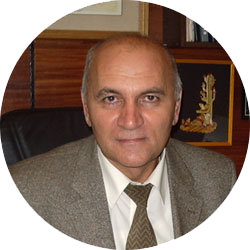USSR Author’s Certificate # 929682, 1974
Mamadzhanov U.D., Bakhir V.M., Shamsutdinova V.N., Bakhir T.M.
The priority of this invention in accordance with Application # 2018444 was established on April 22, 1974. By that time, a two-year period of investigations and industrial tests of electrochemical methods of and devices for drilling mud treatment, which became the basis for electrochemical activation technology, had been over. The above investigations had been performed from 1972 in the Central Asian Research Institute of Natural Gas (SredAzNIIGaz). Drilling mud is a complex poly-disperse system containing clayey mineral particles in water with added organic substances – stabilizers, structure forming agents, thinners and fluid loss additives. The main technological function of drilling mud is bringing drill cuttings from the well bottom to the surface. Clayey particles in drilling mud are normally negatively charged, the charge density depending on surface configuration and chemical composition of clayey particle crystal lattice, as well as on chemical composition and electrolyte content of the liquid phase of drilling mud. Passing current through drilling mud commonly results in deposition on the anode of firm clayey crust made up of the most fine-disperse and highly-charged clayey particles. This crust prevents products of anode electrochemical reactions from entering the drilling mud, therefore the solution’s рН value increases due to cathode, actually unipolar, electrochemical treatment. It was found that in conditions of the same consumed quantity of specific power, the smaller the cathode area as compared to the anode one, the stronger thixotropic properties of drilling mud (structural-mechanic strength) with simultaneously lower dynamic viscosity (paradox). The paradox can be explained in the following way: electric charges accumulated on the edges and pointed parts of tiny scales or needle-like particles of argillaceous minerals are several times stronger than the charges on their flat facets.
Under the influence of electrochemical treatment, in a high voltage electric field close to the cathode surface (in the area of spatial charge), there increased absolute value of particles’ negative charge, thus enhancing their repulsion forces and therefore lowering viscosity. At the same time, however, difference of potentials between the edges and facets of argillaceous particles also increased, causing growth of forces putting in good order structural arrangement of interacting clayey particles. So, drilling mud’s structural and mechanical properties improved due not to mechanical, but to electrostatic adhesion of clayey particles. Investigation of the phenomenon in question both in laboratory and in conditions of real life drilling made it possible to understand specific nature of the processes observed, that is, nonequivalence of electrochemical and chemical regulation methods, and attempt practical application of the discovered effect in the process of oil and gas well drilling. The reported effect had not been known before, therefore the process of unipolar cathode electrochemical treatment of drilling mud was first called by V.M. Bakhir low-voltage polarization, and three years later –electrochemical activation. The above-indicated first invention established a non-chemical method to improve drilling mud parameters by treatment in an engineering electrochemical system consisting of a current power supply and two electrodes, the cathode surface area being smaller than the anode one. In this electrochemical system, the surfaces of drilling rig circulation system coming into contact with drilling mud actually performed the function of anode. Practical trials proved the method’s high efficiency, which allowed saving up to 30 % of chemical reagents commonly used for a well drilling. However, the method had a significant disadvantage, that is, the necessity to periodically remove clayey crust from anode surface and laboriousness of this procedure.
Many other inventions of 1974-1976 not included in the given short list were aimed at further improvement of the discovered method of drilling mud parameters’ control, and technical systems for its implementation. Devices developed at that period were fitted with electrochemical reactors having flat electrodes (steel cathodes, magnetite or graphite anodes) with considerable surface area of a single electrode (from 0.2 to 0.7 m2) intended for high-ampere currents (600-1500 А) to treat large volumes of drilling mud (20-90 liters per second). Monitoring the operation of pilot devices in conditions of drilling deep oil and gas wells revealed that the larger mud volume coming directly into contact with the surface of working (negative) electrode, the higher the degree of drilling mud alterations observed after electrochemical treatment. Interelectrode space of the devices for unipolar (cathodic) electrochemical treatment was not partitioned by a diaphragm. In all modifications of devices developed to implement the effect of unipolar electrochemical exposure, positive electrode with dense clayey crust deposited on it was safely protected by the latter from direct contact with the main bulk of drilling mud. The products of anode electrochemical reactions did not enter the drilling mud as they accumulated in argillaceous solution crust whose thickness generally ranged between 2 and 3 cm.
